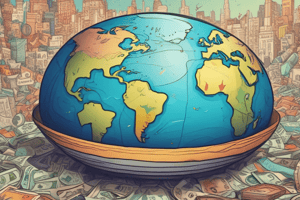Podcast
Questions and Answers
What is the primary focus of the Classical Model in macroeconomics?
What is the primary focus of the Classical Model in macroeconomics?
- Incorporating expectations about future income and prices
- Stimulating aggregate demand
- Emphasizing the role of supply-side factors (correct)
- Accounting for sticky prices and imperfect competition
How does the Keynesian Model propose to stimulate an economy during economic downturns?
How does the Keynesian Model propose to stimulate an economy during economic downturns?
- By using monetary policy tools
- By emphasizing supply-side factors
- By using fiscal policy tools (correct)
- By implementing trade policies
Which macroeconomic tool involves the use of interest rates and money supply to influence an economy?
Which macroeconomic tool involves the use of interest rates and money supply to influence an economy?
- Monetary Policy (correct)
- Trade Policy
- National Budget
- Fiscal Policy
What is the purpose of a country's National Budget in macroeconomics?
What is the purpose of a country's National Budget in macroeconomics?
Which macroeconomic challenge often requires policymakers to make trade-offs due to conflicting goals?
Which macroeconomic challenge often requires policymakers to make trade-offs due to conflicting goals?
What does the Gross Domestic Product (GDP) measure?
What does the Gross Domestic Product (GDP) measure?
Which economic concept is similar to GDP but focuses on the total value of all income earned by residents within a country's borders?
Which economic concept is similar to GDP but focuses on the total value of all income earned by residents within a country's borders?
What does the term 'Unemployment' refer to in economics?
What does the term 'Unemployment' refer to in economics?
Which economic indicator is used to measure a general, sustained rise in prices for goods and services?
Which economic indicator is used to measure a general, sustained rise in prices for goods and services?
What factors determine Aggregate Demand in an economy?
What factors determine Aggregate Demand in an economy?
Study Notes
Exploring Macroeconomics: Understanding the Big Picture of Economics
Macroeconomics, one of the two primary branches of economics, studies the large-scale behavior and performance of whole economies, rather than the actions of individual businesses or consumers. In this article, we'll delve into the core concepts, tools, and policies that make up this fascinating field of study.
Key Concepts
Gross Domestic Product (GDP): A measure of a country's total monetary value of all final goods and services produced within a specific time period, typically a year. GDP serves as a key indicator of an economy's size and health.
National Income: Similar to GDP, but the total value of all income earned by people residing in a country's borders, regardless of the location of production.
Unemployment: The percentage of the labor force that is jobless, seeking employment, and available for work.
Economic Growth: An increase in an economy's output or GDP over time, usually measured as a change in per capita GDP, which takes population growth into account.
Inflation: A general, sustained rise in prices for goods and services, often measured by the Consumer Price Index (CPI).
Aggregate Demand: The total demand for all final goods and services in an economy, which is determined by the aggregate consumption, investment, government spending, and net exports.
Aggregate Supply: The total supply of goods and services produced in an economy, which is influenced by factors like production capacity, technology, and input prices.
National Debt: The total amount of money owed by a government to its creditors, typically measured as a percentage of GDP.
Macroeconomic Tools
National Budget: The government's plan for spending and taxation, which can be used to influence macroeconomic outcomes such as employment, inflation, and economic growth.
Fiscal Policy: The use of government spending, taxation, and debt management to influence an economy's total output, employment, and price levels.
Monetary Policy: The use of interest rates, money supply, and reserve requirements by a central bank to influence the economy's total output, employment, and price levels.
Exchange Rates: The value of one country's currency in terms of another's, which can affect international trade and investment.
Trade Policy: A country's regulatory framework for international trade, including tariffs, quotas, and subsidies, which can impact the economy's competitiveness, growth, and employment.
Common Macroeconomic Models
Classical Model: An early model that emphasized the role of supply-side factors in determining the economy's equilibrium, with little concern for the effects of changes in aggregate demand.
Keynesian Model: Developed by John Maynard Keynes, the model argues that aggregate demand is a key determinant of economic activity, and the government can use fiscal policy to stimulate demand and output during economic downturns.
New Classical Model: An extension of classical models that incorporates expectations about future income and prices, emphasizing the role of supply-side factors and assuming market-clearing prices and full employment in the long run.
New Keynesian Model: An extension of Keynesian models that incorporates sticky prices, imperfect competition, and menu costs, emphasizing the role of aggregate demand and the potential for government intervention in the short run.
Macroeconomic Policy Challenges
Macroeconomic policymakers face numerous challenges in managing an economy, including maintaining low unemployment, controlling inflation, promoting economic growth, and ensuring sustainable public finances. These goals often conflict with one another, requiring policymakers to make trade-offs and exercise sound judgment to steer the economy along a desirable course.
In conclusion, macroeconomics offers a fascinating and challenging exploration of the complexities of whole economies, their interactions, and the tools and policies used to shape them. Whether you're a student of economics or simply an individual interested in understanding the world around you, macroeconomics provides a powerful lens through which to observe and comprehend the many forces at work in our economic lives.
Studying That Suits You
Use AI to generate personalized quizzes and flashcards to suit your learning preferences.
Description
Explore the key concepts, tools, and policies of macroeconomics in this quiz. Test your knowledge on topics such as GDP, national income, unemployment, economic growth, inflation, and more.




